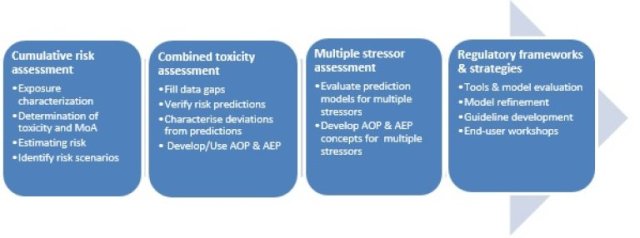MixRisk
Computational and experimental identification and characterisation of cumulative hazard and risk of complex mixtures and multiple stressors under ecologically-relevant exposure scenarios.
About the project
Background
Organisms in the aquatic environment are exposed to mixtures of pollutants, natural stressors and stressors arising from global climate changes. Despite in-depth knowledge of biological effects of single pollutants and stressors, the combined effect of exposures to complex mixtures and multiple stressors are often not known, and even more rarely characterized. Advancement of predictive modelling approaches currently allow assessment of combined toxicity of defined mixtures under controlled laboratory conditions, but have only to a limited degree been implemented in cumulative risk assessment of mixtures and multiple stressors under ecologically relevant exposure scenarios.
Project
The Norwegian Institute for Water Research (NIVA) is managing the Norwegian Research Council (NRC) funded project “268294 - Cumulative hazard and risk assessment of complex mixtures and multiple stressors (MixRisk)" in the period 2017– 2020. The project will host several post docs, PhD and Msc. students, assemble multiple national/international experts in combined toxicity assessment, and contribute to development of hazard/risk assessment through targeted communication, meetings, workshops, and peer-reviewed publications.
Objective
The project aim to improve the assessment of cumulative hazard and risk by 1) identify relevant Norwegian exposure scenarios representing a risk to aquatic organisms, 2) experimentally assess combined toxicity of relevant stressors in a multi-trophic suite of regulatory relevant toxicity tests, 3) assess whether experimental and theoretical combined toxicity and cumulative risk assessment approaches can be applied to multiple stressors, and 4) critically evaluate current experimental and predictive initiatives to propose “Best Practice” approaches that can be routinely used in research and regulatory frameworks.
Work packages
The proposed work will be divided into four work packages (WP) where data and experiences will be shared between the different WPs (Fig. 1). The objectives of the project will be achieved by 1) identifying relevant marine exposure scenarios where combined toxicity due to chemical mixtures and multiple stressors likely causes an environmental risk (WP1), 2) experimentally determine, model and assess the combined toxicity (cumulative hazard) of the relevant pollutant mixtures to a multi-trophic suite of regulatory relevant toxicity tests (WP2), 3) assess whether predictive and experimental approaches used for chemical mixtures are also applicable to multiple stressors (WP3), and 4) critically evaluate current practices and develop guidelines for experimental and predictive approaches in cumulative hazard and risk assessment using existing frameworks for exposure, effect and combined toxicity assessment (WP4).

WP1 - Cumulative risk assessment
Cumulative risk of relevant pollutant mixtures for Norwegian aquatic exposure scenarios will be determined for microalgae, macroalgae, molluscs, crustaceans and/or fish by 1) characterising a selection of case studies, 2) determining compound-specific exposure and effect information, 3) estimating mixture risk quotients and 4) identifying the margin of safety, the toxicity drivers as well as the species at risk.
WP2 - Combined toxicity assessment
Work package 2 aims to experimentally determine single compound and combined toxicity using a selection of bioassays with regulatory-relevant (adverse effects) and supportive effect/biomarker endpoints for selected case studies (identified in WP1). Depending on data/information gaps and hazard and risk scenarios identified in WP1, a need for assessing the effects of a selection of relevant exposure scenarios involving single compound and multi-compound mixtures of relevant pollutants are expected to evaluate the accuracy of the hazard and risk predictions (WP1) and identify deviations from additivity expectations.
WP3 - Multiple stressor assessment (WP3)
Work package 3 aims to critically evaluate whether non-chemical stressors may modify the toxicity of ecological-relevant mixtures of aquatic pollutants, assess the applicability of concentration addition (CA) and independent action (IA) to predict these interactions, and characterise how exposure, toxicokinetics and toxicodynamics information may decipher the complex interactions occurring.
WP4 - Regulatory frameworks & strategies
Work package 4 aim to aid the development and evaluation of tools for hazard and risk assessment of complex mixtures and multiple stressors within the national and international regulations, analogous to previous work on the consideration of mixture toxicities within the EU Biocide Regulation.
Partners and scholarships
Partners
Akvaplan-niva (ApN) - Anita Evenset
Hangzhou Normal University (HZ) - Yang Li
Liverpool John Moores University (LJMU) - Mark Cronin, Judith Madden, Steve Enoch, Sam Belfield and James Firman
Newcastle University (NU) - Gary Caldwell
Norwegian Institute for Air Research (NILU) - Eldbjørg Heimstad
Norwegian Institute for Water Research (NIVA) – Knut Erik Tollefsen, Karina Petersen, Kevin V. Thomas, Bert van Bavel, Anders Ruus
Norwegian University of Life Sciences (NMBU) - Lindis Skipperud, Hans-Christian Teien
University of Gothenburg (UoG) - Thomas Backhaus
University of Minnesota (UoM) / USEPA - Kellie Fay
Scholarships
- Post doc. Kellie Fay (University of Minnesota/USEPA, USA)
- Post doc. James Firman (Liverpool John Moores University, UK)
- PhD. scholar Fern Lyne (Newcastle University, UK)
- MSc. scholar Sam Belfield (Liverpool John Moores University, UK)
- MSc. scholar Denis Napast (Norwegian University of Life Sciences, NO)
- PhD. scholar Emil Jarosz (Norwegian University of Life Sciences, NO)
 Knut Erik Tollefsen
Knut Erik Tollefsen